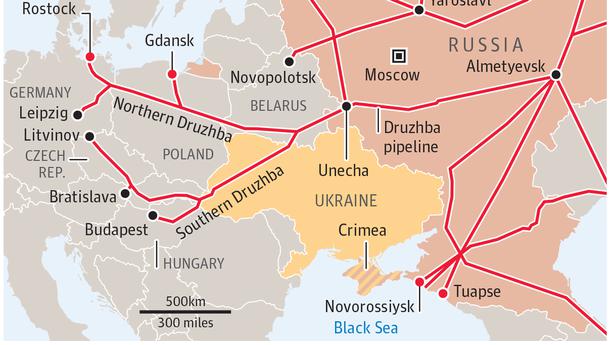
The European Union’s ban on Russian oil
The Hindu
Why is the EU planning to phase out its dependence on Russian crude oil? Will this round of sanctions be the final nail in the coffin for Russia?
The story so far: As part of the sixth package of sanctions since Russia’s invasion of Ukraine, the European Union member states on May 30 reached an agreement to ban 90% of Russian crude oil imports by the end of the year. The partial embargo, worked out following extended negotiations in Brussels, exempts pipeline oil in order to bypass Hungary’s objections to the ban.
The proposal to completely phase out Russian crude and refined products from EU territory within a time frame of six to eight months was first mooted by European Commission President Ursula von der Leyen in early May. Addressing European lawmakers, she sought a “complete import ban on all Russian oil, seaborne and pipeline crude and refined.” It needed the agreement of all the 27 EU member states in order to be implemented.
The Russian economy is heavily dependent on energy exports, with the EU paying billions of dollars every month to Russia for its crude and refined products. The EU wants to block this massive revenue inflow which, as repeatedly pointed out by Ukrainian President Volodymyr Zelensky, is akin to Europeans bankrolling Russia’s war. The EU has been attempting, ever since the Ukraine invasion, to build consensus on ways to hurt Russia economically so that it is forced to roll back its military offensive. The most obvious route was to stop buying Russian energy, which isn’t easy given European households’ dependence on Russian oil and gas.
However, in the context of two long term EU objectives — reducing fossil fuel dependence in favour of renewables, and eliminating dependence on Russian energy for greater strategic autonomy and energy security — member states agreed to make a start by phasing out Russian oil.
The main departure from the original proposal is the “temporary exemption” from the oil embargo for countries that import Russian crude via pipeline. In other words, EU leaders have, in principle, agreed to ban all seaborne imports of Russian crude, which account for two-thirds of EU’s oil imports from Russia. However, with Germany and Poland pledging to phase out even their pipeline imports from Russia by the end of the year, the embargo would eliminate 90% of Russian oil imports. The remaining 10% that’s been allowed represents a free pass for Hungary, the Czech Republic, Slovakia, and Bulgaria to continue imports via the Druzhba pipeline, the world’s largest oil pipeline network. Additionally, Hungary has obtained a guarantee that it could even import seaborne Russian oil in case of a disruption to their pipeline supplies.
This was deemed a legitimate concession since the pipelines do pass through the war zone in Ukraine.
The exemption for pipeline imports — essentially at the behest of Hungarian Prime Minister Viktor Orban — was made on the logic that landlocked countries (Hungary, Czech Republic and Slovakia) that are heavily dependent on Russian pipeline oil do not have a ready option to switch to alternative sources in the absence of ports. While Hungary imports 65% of its oil via pipeline from Russia, 50% of the Czech Republic’s oil imports are Russian, while Slovakia gets 100% of its oil from Russia. Bulgaria, which gets 60% of its oil from Russia, is not landlocked. But its refineries at present are only equipped to process Russian crude.

“Writing, in general, is a very solitary process,” says Yauvanika Chopra, Associate Director at The New India Foundation (NIF), which, earlier this year, announced the 12th edition of its NIF Book Fellowships for research and scholarship about Indian history after Independence. While authors, in general, are built for it, it can still get very lonely, says Chopra, pointing out that the fellowship’s community support is as valuable as the monetary benefits it offers. “There is a solid community of NIF fellows, trustees, language experts, jury members, all of whom are incredibly competent,” she says. “They really help make authors feel supported from manuscript to publication, so you never feel like you’re struggling through isolation.”

Several principals of government and private schools in Delhi on Tuesday said the Directorate of Education (DoE) circular from a day earlier, directing schools to conduct classes in ‘hybrid’ mode, had caused confusion regarding day-to-day operations as they did not know how many students would return to school from Wednesday and how would teachers instruct in two modes — online and in person — at once. The DoE circular on Monday had also stated that the option to “exercise online mode of education, wherever available, shall vest with the students and their guardians”. Several schoolteachers also expressed confusion regarding the DoE order. A government schoolteacher said he was unsure of how to cope with the resumption of physical classes, given that the order directing government offices to ensure that 50% of the employees work from home is still in place. On Monday, the Commission for Air Quality Management in the National Capital Region and Adjoining Areas (CAQM) had, on the orders of the Supreme Court, directed schools in Delhi-NCR to shift classes to the hybrid mode, following which the DoE had issued the circular. The court had urged the Centre’s pollution watchdog to consider restarting physical classes due to many students missing out on the mid-day meals and lacking the necessary means to attend classes online. The CAQM had, on November 20, asked schools in Delhi-NCR to shift to the online mode of teaching.









